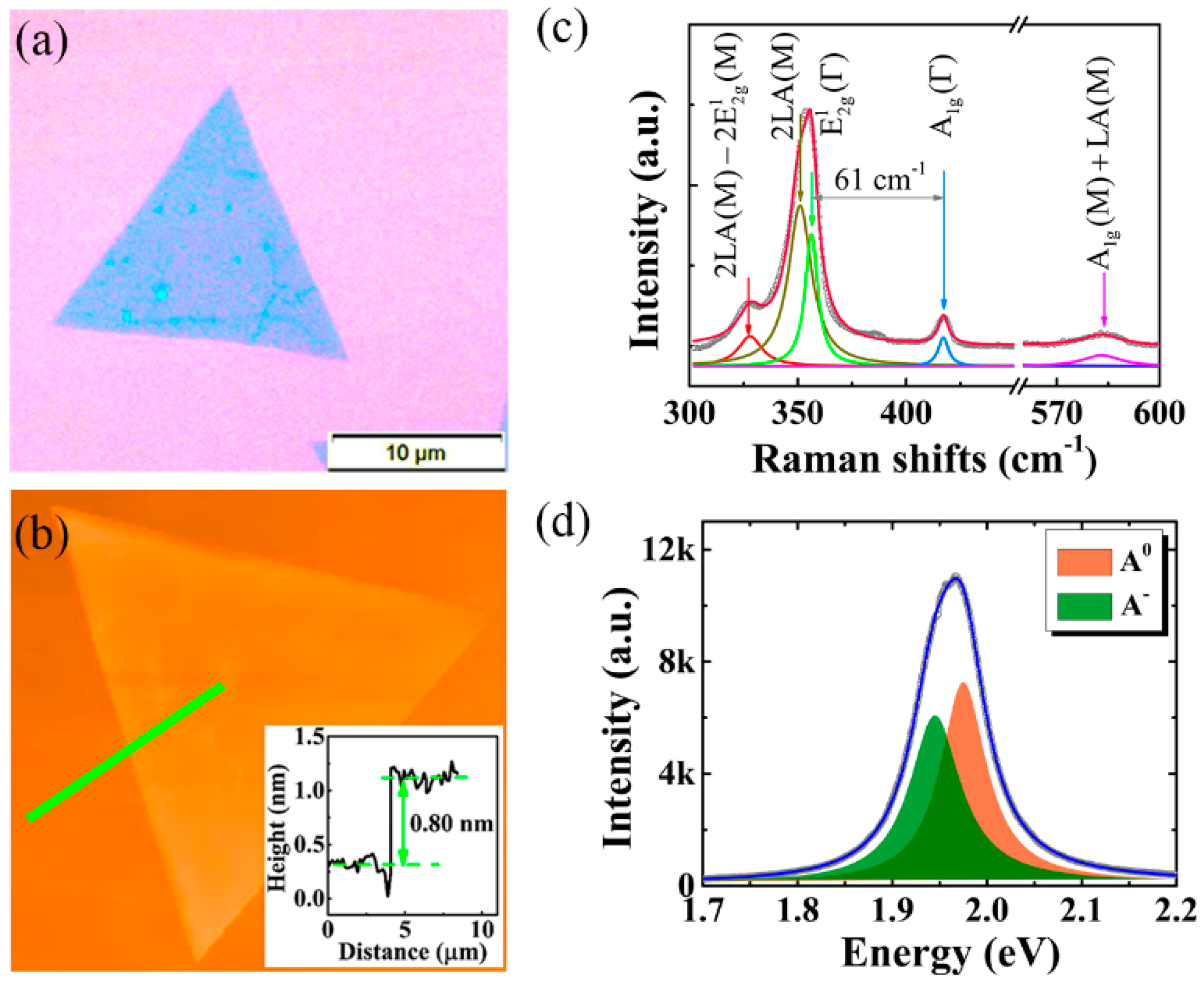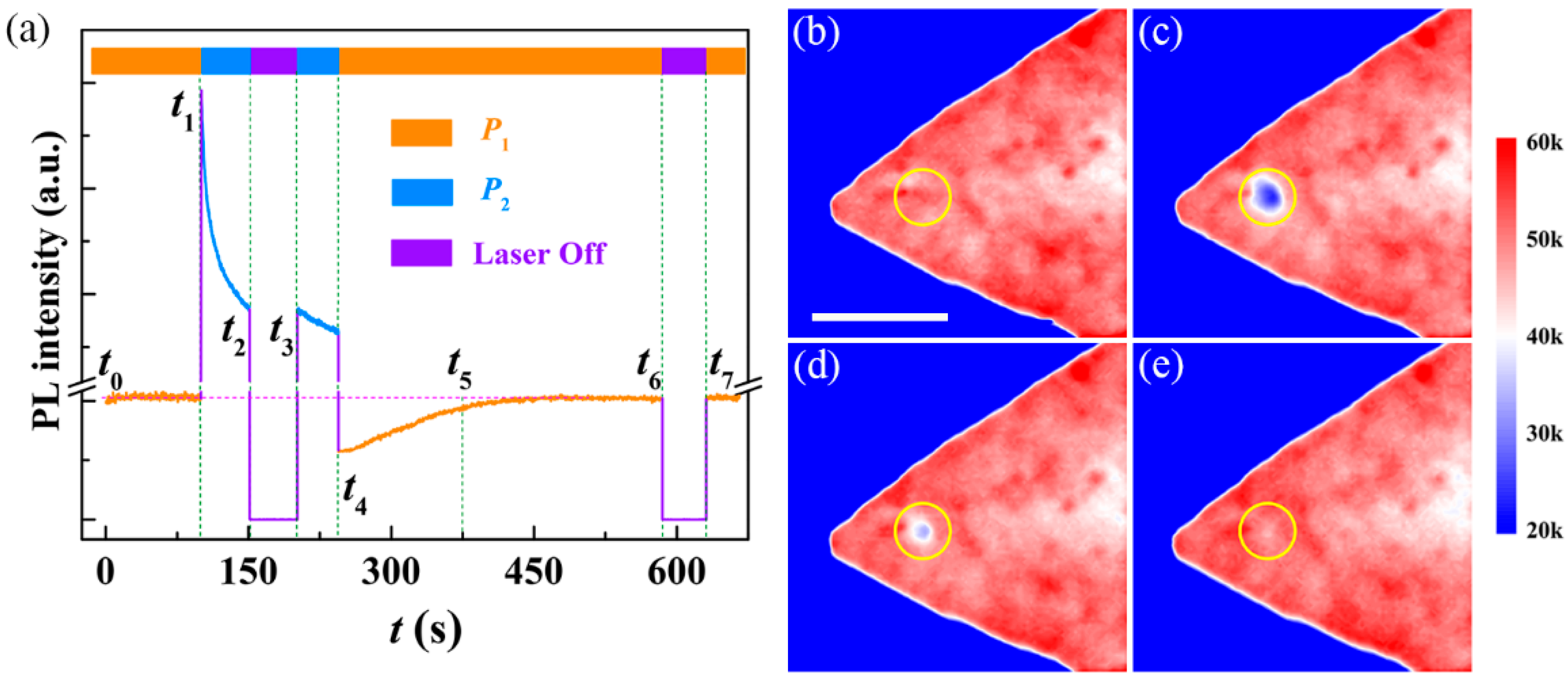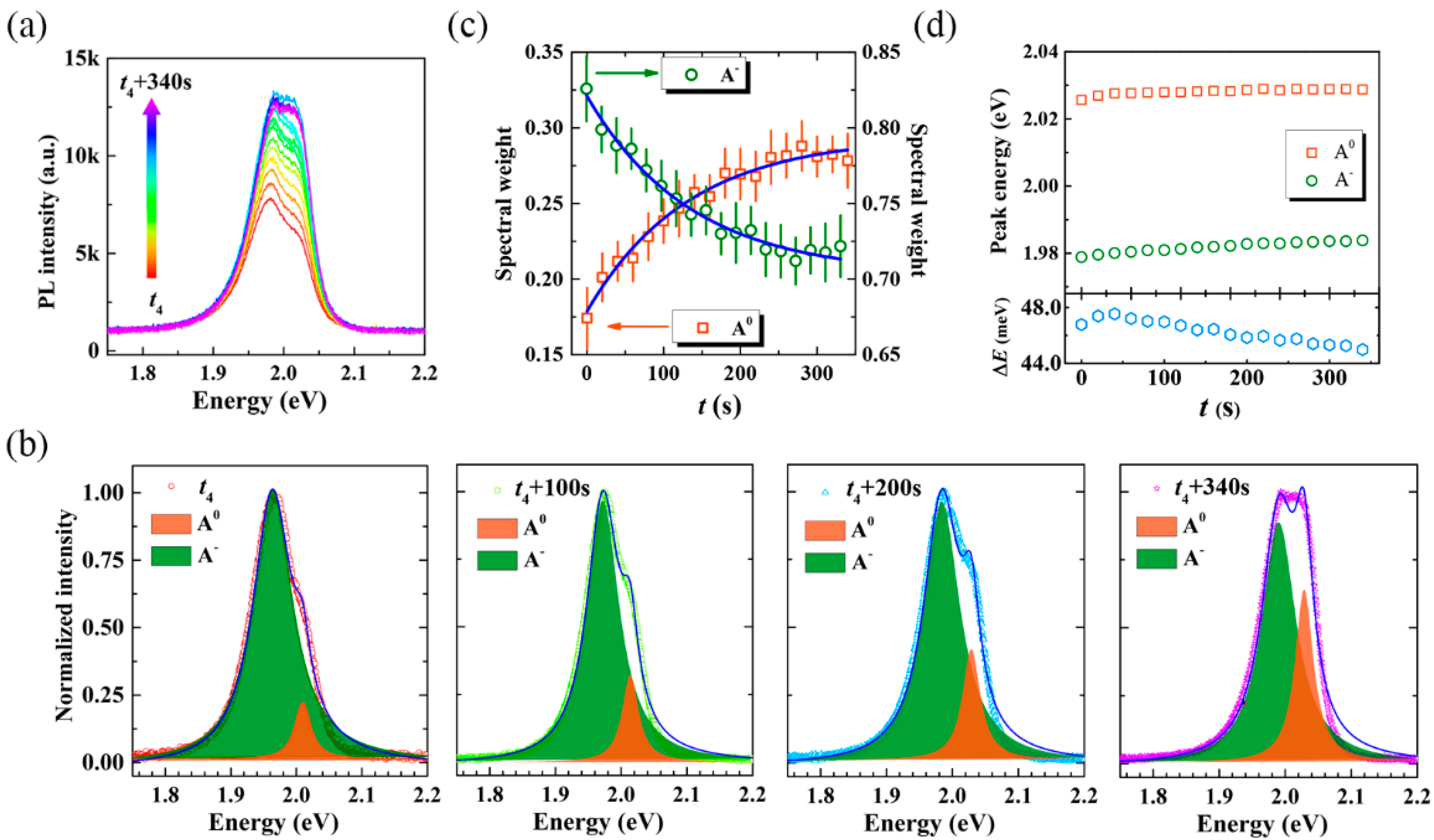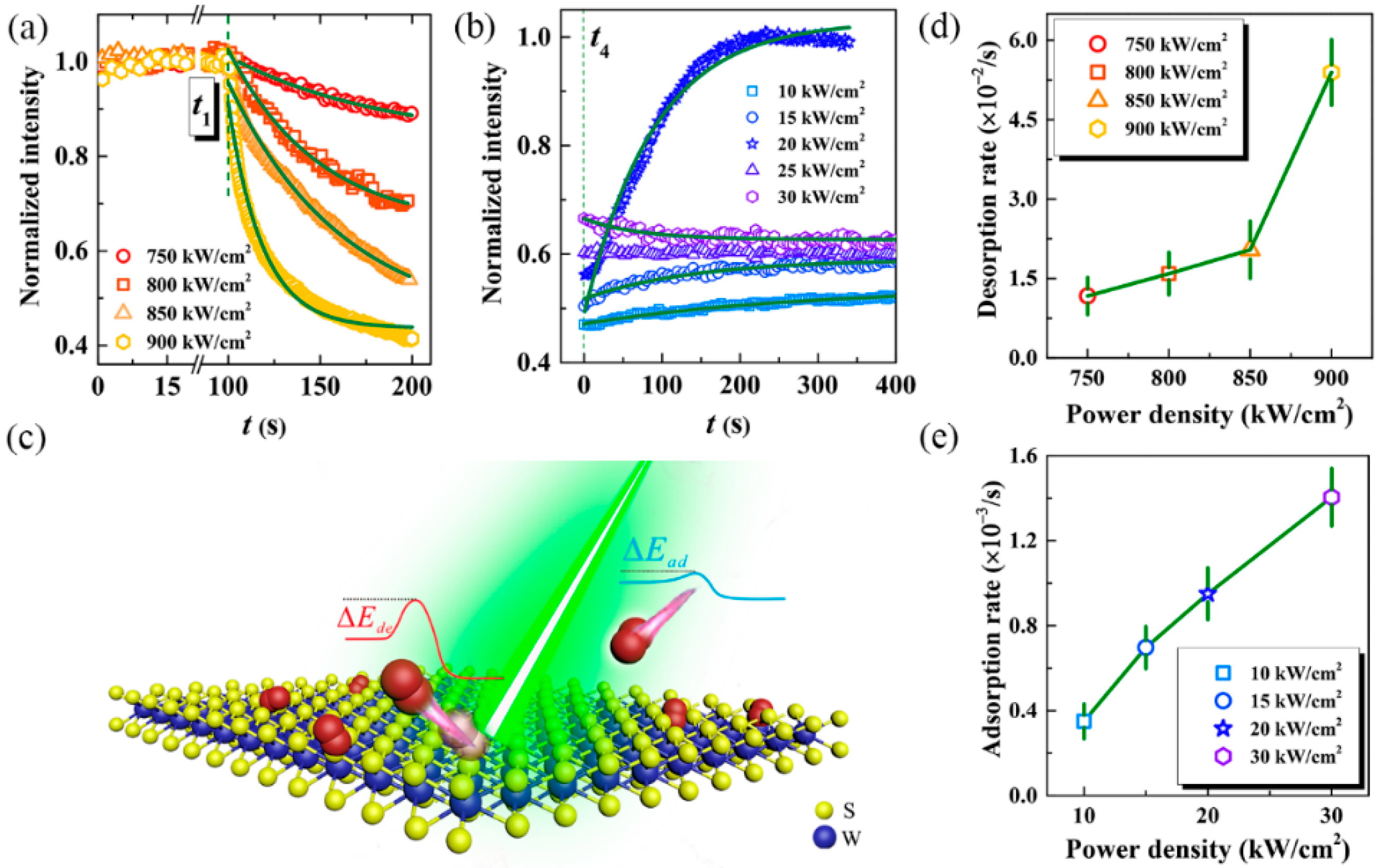All-Optical Reversible Manipulation of Exciton and Trion Emissions in Monolayer WS2
Abstract
1. Introduction
2. Experimental Section
3. Results and Discussion
3.1. Sample Characterizations
3.2. All-Optical Reversible Manipulation of the Exciton and Trion Emissions
3.3. Proposed Mechanism to Explain the Manipulation
- (I).
- At the initial stage, monolayer WS2 is irradiated by the low power density. Hence the laser-induced heat effect is not pronounced. Therefore, the activation energy is not high enough for desorbing gas molecules from the surface. Although adsorption may occur during this stage, the molecule concentration has already reached saturation before laser irradiation. Consequently, no more gas molecules can be adsorbed, and PL of monolayer WS2 will maintain, as t0 to t1 shown in Figure 2a.
- (II).
- When the activation energy for desorbing gas molecules has been reached by laser irradiation with the high power density, the adsorbed gas molecules will fly away from the surface of monolayer WS2. Even though adsorption also occurs during this stage, we can still image that the number of desorbing molecules is much larger than that of adsorbing. This is readily understood by considering that the dense pre-adsorbed molecules can fly away directly and rapidly, while the new-adsorbed molecules have to fly from the ambient atmosphere. Consequently, the concentration of adsorbed molecules will decrease while the free electrons will increase, resulting in the conversion from A0 to A− and the quenching of PL, as t1 to t2 shown in Figure 2a. The increased power density will improve the heat effect and thus increase the activation energy. According to the Arrhenius law, the desorption rate will increase synchronously. Thus, PL quenching will become more significantly under higher power density, as PL trajectories presented in Figure 5a.
- (III).
- When the irradiation laser is tuned from the high power density to the low power density (such as P2 to P1 shown in Figure 2a), the desorption will be switched off while the adsorption may still survive. In the case, the molecule concentration adsorbed on the WS2 surface will increase, and thus the free electrons will be depleted. Consequently, the conversion from A− to A0 happens and PL will be restored, as t4 to t5 shown in Figure 2a. Similarly, the recovery process becomes obvious as the power density increases. However, PL may stand at a plateau level or even quench again when the power density is high enough so that the desorption process is activated again, as 25 kW/cm2 and 30 kW/cm2 shown in Figure 5b.
3.4. Discussion
4. Conclusions
Supplementary Materials
Author Contributions
Funding
Acknowledgments
Conflicts of Interest
References
- Duan, X.; Wang, C.; Pan, A.; Yu, R.; Duan, X. Two-dimensional transition metal dichalcogenides as atomically thin semiconductors: Opportunities and challenges. Chem. Soc. Rev. 2015, 44, 8859–8876. [Google Scholar] [CrossRef] [PubMed]
- Wang, Q.H.; Kalantar-Zadeh, K.; Kis, A.; Coleman, J.N.; Strano, M.S. Electronics and optoelectronics of two-dimensional transition metal dichalcogenides. Nat. Nanotechnol. 2012, 7, 699–712. [Google Scholar] [CrossRef] [PubMed]
- Mak, K.F.; Lee, C.; Hone, J.; Shan, J.; Heinz, T.F. Atomically Thin MoS2: A New Direct-Gap Semiconductor. Phys. Rev. Lett. 2010, 105, 136805. [Google Scholar] [CrossRef] [PubMed]
- Lee, Y.; Ghimire, G.; Roy, S.; Kim, Y.; Seo, C.; Sood, A.K.; Jang, J.I.; Kim, J. Impeding Exciton–Exciton Annihilation in Monolayer WS2 by Laser Irradiation. ACS Photonics 2018, 5, 2904–2911. [Google Scholar] [CrossRef]
- Sun, D.; Rao, Y.; Reider, G.A.; Chen, G.; You, Y.; Brézin, L.; Harutyunyan, A.R.; Heinz, T.F. Observation of rapid exciton-exciton annihilation in monolayer molybdenum disulfide. Nano Lett. 2014, 14, 5625–5629. [Google Scholar] [CrossRef]
- Yuan, L.; Huang, L. Exciton dynamics and annihilation in WS2 2D semiconductors. Nanoscale 2015, 7, 7402–7408. [Google Scholar] [CrossRef]
- Mak, K.F.; He, K.; Lee, C.; Lee, G.H.; Hone, J.; Heinz, T.F.; Shan, J. Tightly bound trions in monolayer MoS2. Nat. Mater. 2013, 12, 207–211. [Google Scholar] [CrossRef]
- Ross, J.S.; Wu, S.; Yu, H.; Ghimire, N.J.; Jones, A.M.; Aivazian, G.; Yan, J.; Mandrus, D.G.; Xiao, D.; Yao, W.; et al. Electrical control of neutral and charged excitons in a monolayer semiconductor. Nat. Commun. 2013, 4, 1474. [Google Scholar] [CrossRef]
- Mouri, S.; Miyauchi, Y.; Matsuda, K. Tunable photoluminescence of monolayer MoS2 via chemical doping. Nano Lett. 2013, 13, 5944–5948. [Google Scholar] [CrossRef]
- Chow, P.K.; Jacobs-Gedrim, R.B.; Gao, J.; Lu, T.-M.; Yu, B.; Terrones, H.; Koratkar, N. Defect-induced photoluminescence in monolayer semiconducting transition metal dichalcogenides. ACS Nano 2015, 9, 1520–1527. [Google Scholar] [CrossRef]
- Korn, T.; Heydrich, S.; Hirmer, M.; Schmutzler, J.; Schuüller, C. Low-temperature photocarrier dynamics in monolayer MoS2. Appl. Phys. Lett. 2011, 99, 102109. [Google Scholar] [CrossRef]
- Fan, X.; Zheng, W.; Liu, H.; Zhuang, X.; Fan, P.; Gong, Y.; Li, H.; Wu, X.; Jiang, Y.; Zhu, X.; et al. Nonlinear photoluminescence in monolayer WS2: Parabolic emission and excitation fluence-dependent recombination dynamics. Nanoscale 2017, 9, 7235–7241. [Google Scholar] [CrossRef]
- Kim, M.S.; Yun, S.J.; Lee, Y.; Seo, C.; Han, G.H.; Kim, K.K.; Lee, Y.H.; Kim, J. Biexciton Emission from Edges and Grain Boundaries of Triangular WS2 Monolayers. ACS Nano 2016, 10, 2399–2405. [Google Scholar] [CrossRef]
- Peimyoo, N.P.; Yang, W.H.; Shang, J.Z.; Shen, X.N.; Wang, Y.L.; Yu, T. Chemically driven tunable light emission of charged and neutral excitons in monolayer WS2. ACS Nano 2014, 8, 11320–11329. [Google Scholar] [CrossRef]
- Iqbal, M.W.; Khan, M.F.; Alharbi, T.; Kamran, M.A.; Majid, A.; Eom, J. Tailoring the electrical and photo-electrical properties of a WS2 field effect transistor by selective n-type chemical doping. RSC Adv. 2016, 6, 24675–24682. [Google Scholar] [CrossRef]
- Feng, S.; Cong, C.; Peimyoo, N.; Chen, Y.; Shang, J.; Zou, C.; Cao, B.; Wu, L.; Zhang, J.; Eginligil, M.; et al. Tunable excitonic emission of monolayer WS2 for the optical detection of DNA nucleobases. Nano Res. 2018, 11, 1744–1754. [Google Scholar] [CrossRef]
- Newaz, A.; Prasai, D.; Ziegler, J.; Caudel, D.; Robinson, S.R.H., Jr.; Bolotin, K. Electrical control of optical properties of monolayer MoS2. Solid State Commun. 2013, 155, 49–52. [Google Scholar] [CrossRef]
- Tongay, S.; Zhou, J.; Ataca, C.; Liu, J.; Kang, J.S.; Matthews, T.S.; You, L.; Li, J.; Grossman, J.C.; Wu, J. Broad-range modulation of light emission in two-dimensional semiconductors by molecular physisorption gating. Nano Lett. 2013, 13, 2831–2836. [Google Scholar] [CrossRef]
- He, W.; Qin, C.; Qiao, Z.; Zhang, G.; Xiao, L.; Jia, S. Two fluorescence lifetime components reveal the photoreduction dynamics of monolayer graphene oxide. Carbon 2016, 109, 264–268. [Google Scholar] [CrossRef]
- Qin, C.; Qiao, Z.; He, W.; Gong, Y.; Zhang, G.; Chen, R.; Gao, Y.; Xiao, L.; Jia, S. Laser-driven propulsion of multilayer graphene oxide flakes. J. Mater. Chem. C. 2018, 6, 2329–2335. [Google Scholar] [CrossRef]
- Cadiz, F.; Kong, W.; Fan, X.; Blei, M.; Lagarde, D.; Gay, M.; Manca, M.; Taniguchi, T.; Amand, T.; Marie, X.; et al. Ultra-low power threshold for laser induced changes in optical properties of 2D molybdenum dichalcogenides. 2D Mater. 2016, 3, 045008. [Google Scholar] [CrossRef]
- Van Ngoc, H.; Qian, Y.; Han, S.K.; Kang, D.J. PMMA-Etching-Free Transfer of Wafer-scale Chemical Vapor Deposition Two-dimensional Atomic Crystal by a Water Soluble Polyvinyl Alcohol Polymer Method. Sci. Rep. 2016, 6, 33096. [Google Scholar] [CrossRef]
- Gong, Y.; Lin, Z.; Ye, G.; Shi, G.; Feng, S.; Lei, Y.; Elías, A.L.; Perea-López, N.; Vajtai, R.; Terrones, H.; et al. Tellurium-Assisted Low-Temperature Synthesis of MoS2 and WS2 Monolayers. ACS Nano 2015, 9, 11658–11666. [Google Scholar] [CrossRef]
- Zhao, W.; Ghorannevis, Z.; Amara, K.K.; Pang, J.R.; Toh, M.; Zhang, X.; Kloc, C.; Tan, P.H.; Eda, G. Lattice dynamics in mono-and few-layer sheets of WS2 and WSe2. Nanoscale 2013, 5, 9677–9683. [Google Scholar] [CrossRef]
- Del Corro, E.; Botello-Méndez, A.; Gillet, Y.; Elías, A.L.; Terrones, H.; Feng, S.; Fantini, C.; Rhodes, D.; Pradhan, N.R.; Balicas, L.; et al. Atypical Exciton-Phonon Interactions in WS2 and WSe2 Monolayers Revealed by Resonance Raman Spectroscopy. Nano Lett. 2016, 16, 2363–2368. [Google Scholar] [CrossRef]
- Molas, M.R.; Nogajewski, K.; Potemski, M.; Babinski, A. Raman scattering excitation spectroscopy of monolayer WS2. Sci. Rep. 2017, 7, 5036. [Google Scholar] [CrossRef]
- Berkdemir, A.; Gutiérrez, H.R.; Botello-Méndez, A.R.; Perea-López, N.; Elías, A.L.; Chia, C.-I.; Wang, B.; Crespi, V.H.; López-Urías, F.; Charlier, J.-C.; et al. Identification of individual and few layers of WS2 using Raman Spectroscopy. Sci. Rep. 2013, 3, 1755. [Google Scholar] [CrossRef]
- Currie, M.; Hanbicki, A.T.; Kioseoglou, G.; Jonker, B.T. Optical control of charged exciton states in tungsten disulfide. Appl. Phys. Lett. 2015, 106, 201907. [Google Scholar] [CrossRef]
- Jadczak, J.; Kutrowska-Girzycka, J.; Kapuścińsji, P.; Huang, Y.S.; Wόjs, A.; Bryja, L. Probing of free and localized excitons and trions in atomically thin WSe2, WS2, MoSe2 and MoS2 in photoluminescence and reflectivity experiments. Nanotechnology 2017, 28, 395702. [Google Scholar] [CrossRef]
- Nan, H.; Wang, Z.; Wang, W.; Liang, Z.; Lu, Y.; Chen, Q.; He, D.; Tan, P.-H.; Miao, F.; Wang, X.; et al. Strong Photoluminescence Enhancement of MoS2 through Defect Engineering and Oxygen Bonding. ACS Nano 2014, 8, 5738–5745. [Google Scholar] [CrossRef]
- Venkatakrishnan, A.; Chua, H.; Tan, P.; Hu, Z.; Liu, H.; Liu, Y.; Carvalho, A.; Lu, J.; Sow, C.H. Microsteganography on WS2 Monolayers Tailored by Direct Laser Painting. ACS Nano 2017, 11, 713–720. [Google Scholar] [CrossRef]
- Qiao, Z.; Qin, C.; He, W.; Gong, Y.; Zhang, G.; Chen, R.; Gao, Y.; Xiao, L.; Jia, S. Versatile and scalable micropatterns on graphene oxide films based on laser induced fluorescence quenching effect. Opt. Express 2017, 25, 31025–31035. [Google Scholar] [CrossRef]
- Zhu, B.; Chen, X.; Cui, X. Exciton binding energy of monolayer WS2. Sci. Rep. 2015, 5, 9218. [Google Scholar] [CrossRef]
- Mitioglu, A.A.; Plochocka, P.; Jadczak, J.N.; Escoffier, W.; Rikken, G.L.J.A.; Kulyuk, L.; Maude, D.K. Optical manipulation of the exciton charge state in single-layer tungsten disulfide. Phys. Rev. B 2013, 88, 245403. [Google Scholar] [CrossRef]
- Oh, H.M.; Han, G.H.; Kim, H.; Bae, J.J.; Jeong, M.S.; Lee, Y.H. Photochemical Reaction in Monolayer MoS2 via Correlated Photoluminescence, Raman Spectroscopy, and Atomic Force Microscopy. ACS Nano 2016, 10, 5230–5236. [Google Scholar] [CrossRef]
- Gordo, V.O.; Balanta, M.A.G.; Gobato, Y.G.; Covre, F.S.; Galeti, H.V.A.; Iikawa, F.; Couto, O.D.D.; Qu, F.; Henini, M.; Hewak, D.W.; et al. Revealing the nature of low-temperature photoluminescence peaks by laser treatment in van der Waals epitaxially grown WS2 monolayers. Nanoscale 2018, 10, 4807–4815. [Google Scholar] [CrossRef]
- Gong, Y.; Qin, C.; He, W.; Qiao, Z.; Zhang, G.; Chen, R.; Gao, Y.; Xiao, L.; Jia, S. Solar light assisted green synthesis of photoreduced graphene oxide for the high-efficiency adsorption of anionic dyes. RSC Adv. 2017, 7, 53362–53372. [Google Scholar] [CrossRef]
- Salehzadeh, O.; Tran, N.H.; Liu, X.; Shih, I.; Mi, Z. Exciton kinetics, quantum efficiency, and efficiency droop of monolayer MoS2 light-emitting devices. Nano Lett. 2014, 14, 4125–4130. [Google Scholar] [CrossRef]
- Tongay, S.; Zhou, J.; Ataca, C.; Lo, K.; Matthews, T.S.; Li, J.; Grossman, J.C.; Wu, J. Thermally driven crossover from indirect toward direct bandgap in 2D semiconductors: MoSe2 versus MoS2. Nano Lett. 2012, 12, 5576–5580. [Google Scholar] [CrossRef]





© 2019 by the authors. Licensee MDPI, Basel, Switzerland. This article is an open access article distributed under the terms and conditions of the Creative Commons Attribution (CC BY) license (http://creativecommons.org/licenses/by/4.0/).
Share and Cite
Yang, C.; Gao, Y.; Qin, C.; Liang, X.; Han, S.; Zhang, G.; Chen, R.; Hu, J.; Xiao, L.; Jia, S. All-Optical Reversible Manipulation of Exciton and Trion Emissions in Monolayer WS2. Nanomaterials 2020, 10, 23. https://doi.org/10.3390/nano10010023
Yang C, Gao Y, Qin C, Liang X, Han S, Zhang G, Chen R, Hu J, Xiao L, Jia S. All-Optical Reversible Manipulation of Exciton and Trion Emissions in Monolayer WS2. Nanomaterials. 2020; 10(1):23. https://doi.org/10.3390/nano10010023
Chicago/Turabian StyleYang, Chaoli, Yan Gao, Chengbing Qin, Xilong Liang, Shuangping Han, Guofeng Zhang, Ruiyun Chen, Jianyong Hu, Liantuan Xiao, and Suotang Jia. 2020. "All-Optical Reversible Manipulation of Exciton and Trion Emissions in Monolayer WS2" Nanomaterials 10, no. 1: 23. https://doi.org/10.3390/nano10010023
APA StyleYang, C., Gao, Y., Qin, C., Liang, X., Han, S., Zhang, G., Chen, R., Hu, J., Xiao, L., & Jia, S. (2020). All-Optical Reversible Manipulation of Exciton and Trion Emissions in Monolayer WS2. Nanomaterials, 10(1), 23. https://doi.org/10.3390/nano10010023




